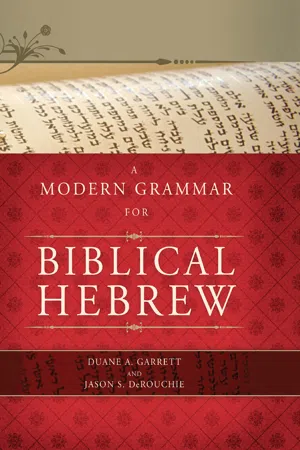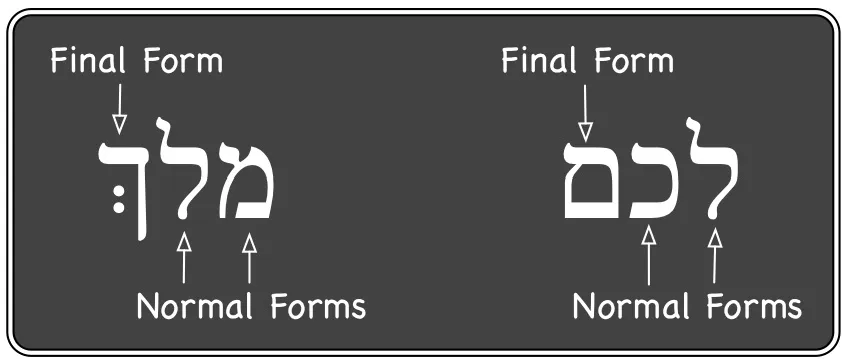
- 366 pages
- English
- ePUB (mobile friendly)
- Available on iOS & Android
eBook - ePub
A Modern Grammar for Biblical Hebrew
About this book
A Modern Grammar for Biblical Hebrew is a complete revision of Duane Garrett's respected 2002 release originally entitled A Modern Grammar for Classical Hebrew. In addition to the revisions and contributions from new coauthor Jason DeRouchie, the book now includes the answer key for an all-new companion workbook and an updated vocabulary list for second year Hebrew courses.
Frequently asked questions
Yes, you can cancel anytime from the Subscription tab in your account settings on the Perlego website. Your subscription will stay active until the end of your current billing period. Learn how to cancel your subscription.
No, books cannot be downloaded as external files, such as PDFs, for use outside of Perlego. However, you can download books within the Perlego app for offline reading on mobile or tablet. Learn more here.
Perlego offers two plans: Essential and Complete
- Essential is ideal for learners and professionals who enjoy exploring a wide range of subjects. Access the Essential Library with 800,000+ trusted titles and best-sellers across business, personal growth, and the humanities. Includes unlimited reading time and Standard Read Aloud voice.
- Complete: Perfect for advanced learners and researchers needing full, unrestricted access. Unlock 1.4M+ books across hundreds of subjects, including academic and specialized titles. The Complete Plan also includes advanced features like Premium Read Aloud and Research Assistant.
We are an online textbook subscription service, where you can get access to an entire online library for less than the price of a single book per month. With over 1 million books across 1000+ topics, we’ve got you covered! Learn more here.
Look out for the read-aloud symbol on your next book to see if you can listen to it. The read-aloud tool reads text aloud for you, highlighting the text as it is being read. You can pause it, speed it up and slow it down. Learn more here.
Yes! You can use the Perlego app on both iOS or Android devices to read anytime, anywhere — even offline. Perfect for commutes or when you’re on the go.
Please note we cannot support devices running on iOS 13 and Android 7 or earlier. Learn more about using the app.
Please note we cannot support devices running on iOS 13 and Android 7 or earlier. Learn more about using the app.
Yes, you can access A Modern Grammar for Biblical Hebrew by Duane A. Garrett,Jason S. DeRouchie in PDF and/or ePUB format, as well as other popular books in Theology & Religion & Biblical Reference. We have over one million books available in our catalogue for you to explore.
Information
Chapter 1The Hebrew Alphabet and Vowels
The Hebrew alphabet consists entirely of consonants, the first being א (Aleph) and the last being ת (Taw). The standard script for biblical Hebrew is called the square or Aramaic script. Modern Hebrew uses a wide variety of scripts.
A. The Consonants
1. The Letters of the Alphabet
To master the Hebrew alphabet, first learn the signs, their names, and their alphabetical order.
Table 1.1. The Hebrew Alphabet
| 1 | א | Aleph | 7 | ז | Zayin | 13 | מ | Mem | 19 | ק | Qoph |
| 2 | ב | Beth | 8 | ח | Heth | 14 | נ | Nun | 20 | ר | Resh |
| 3 | ג | Gimel | 9 | ט | Teth | 15 | ס | Samek | 21 | שׂ | Sin |
| 4 | ד | Daleth | 10 | י | Yod | 16 | ע | Ayin | 22 | שׁ | Shin |
| 5 | ה | Hey | 11 | כ | Kaph | 17 | פ | Pe | 23 | ת | Taw |
| 6 | ו | Waw | 12 | ל | Lamed | 18 | צ | Tsade |
The alphabet has 23 letters, but in biblical times שׂ (Sin) and שׁ (Shin) were counted as one letter, and thus it had 22 letters. It is written from right to left, so that in the word written אשׁ, the letter א is first and the letter שׁ is last.
2. Letters with Final Forms
Five letters have final forms. Whenever one of these letters is the last letter in a word, it is written in its final form rather than its normal form. For example, the final form of צ (Tsade) is ץ. Both forms represent the same letter; it is simply written differently if it is the last letter in the word. The five final forms are as follows.
Table 1.2. Consonants with Final Forms
| Normal Form | כ | מ | נ | פ | צ |
| Final Form | ךְ | ם | ן | ף | ץ |
- In מלךְ (mlk), מ (the first letter, reading right to left) has the normal form, but the last letter in the word is כ in its final form (ךְ).
- In לכם (lkm), כ has the normal form, but מ has the final form (ם).

3. Confusing Letters
Hebrew can be difficult to read because many letters look similar. Observe the letters in the following chart. In each box, you see a series of letters that look like one another. Be sure that you can distinguish which letter is which.
Table 1.3. Easily Confused Letters
| צ ע | ם ט מ ס | ן ז ו י | ךְ ר ד |
| פ כ ב | ת ח ה | ו ג נ |
4. The Phonetic Value of the Alphabet
For learning the alphabet, Hebrew consonants can be divided conveniently into six groups: begadkephat letters, sibilants, ט and ק, gutturals, liquids, and nasals. These six groups are not built around phonetic definitions. They simply provide a framework for learning to pronounce the letters of the Hebrew alphabet.
a. Begadkephat Letters
Referred to as the begadkephat letters, the letters ב, ג, ד, כ, פ, and ת are unique in that each has two distinct phonetic values. Each of these may be found with a dot called a Daghesh Lene (בּ) or without the Daghesh Lene (ב).
- If the Daghesh Lene is present, the letter is a plosive, like the English P or B.
- If there is no Daghesh Lene, the sound is a fricative or spirant (there is a breathing sound, as with the English F sound).
- Do not think of the begadkephat letters as twelve different letters. There are only six, each with or without the Daghesh Lene.
- The Daghesh Lene is used only with these six letters.
- In a given word the same begadkephat letter will be written sometimes with and sometimes without a Daghesh Lene, according to rules we will learn in the next chapter.
Table 1.4. The “Begadkephat” Letters
| With Daghesh Lene | |||||
| בּ | גּ | דּ | כּ | פּ | תּ |
| B | G | D | K | P | T |
| boy | good | dot | kite | paste | tin |
| Without Daghesh Lene | |||||
| ב | ג | ד | כ | פ | ת |
| V | GH | voiced | C | F | unvoiced |
| very | dog | TH | cool | fix | TH |
| house | then | thin | |||
b. The Gutturals
Hebrew has four guttural letters: א, ע, ה, and ח. The sounds of these letters are made at the back of the throat. For English speakers, the “sound” of...
Table of contents
- Chapter 1: The Hebrew Alphabet and Vowels
- Chapter 2: Pointed Vowel Letters and the Silent Shewa
- Chapter 3: Daghesh Forte, Mappiq, Metheg, and Rules for Gutturals
- Chapter 4: Accent Shift and Vowel Changes
- Chapter 5: Gender and Number in Nouns
- Chapter 6: Hebrew Verbs
- Chapter 7: The Directive ה, Negative אַל and Interrogative ה
- Chapter 8: The Definite Article
- Chapter 9: Roots, Stems, and the Qal Qatal
- Chapter 10: The Conjunction and the Qal Yiqtol and Weqatal
- Chapter 11: The Qal Infinitive Construct and Wayyiqtol
- Chapter 12: The Construct Chain
- Chapter 13: Prepositions
- Chapter 14: Pronominal Suffixes on Nouns and Prepositions
- Chapter 15: Adjectives and the Qal Participles
- Chapter 16: Geminate and Segholate Nouns
- Chapter 17: Pronouns
- Chapter 18: More About יֵשׁ and אֵין and the Qal Imperative
- Chapter 19: Numbers
- Chapter 20: Stems, Roots, and Principal Parts
- Chapter 21: Principal Parts of Other Weak Roots in the Qal Stem
- Chapter 22: Characteristics of the Niphal, Piel, and Hiphil
- Chapter 23: Characteristics of the Pual, Hophal, and Hithpael
- Chapter 24: Principal Parts of Weak Roots in the Derived Stems
- Chapter 25: Pronominal Suffixes on Verbs
- Chapter 26: Infinitive Constructs with Suffixes and Infinitive Absolutes
- Chapter 27: The Qal Yiqtol and Wayyiqtol with Weak Roots
- Chapter 28: The Qal Imperative and Participle with Weak Roots
- Chapter 29: The Qal Qatal, Statives, and Passive Participle
- Chapter 30: The Qal Cohortative, Jussive, and Weyiqtol
- Chapter 31: The Niphal
- Chapter 32: The Piel and Pual
- Chapter 33: The Hiphil and Hophal
- Chapter 34: The Hithpael
- Chapter 35: The Alternative Doubled Stems
- Chapter 36: The Cantillation Marks and Other Masoretic Conventions
- Chapter 37: An Overview of Text Syntax and Literary Structure
- Chapter 38: More on Historical Discourse, Connectors, and Subordination
- Chapter 39: More on Anticipatory Discourse and Copular Clauses
- Chapter 40: Discourse Markers and More on Directive Discourse
- Chapter 41: An Overview of Poetry
- Appendix 1: Glossary for the Study of Hebrew Grammar
- Appendix 2: Hebrew-English Vocabulary—By Chapter
- Appendix 3: Vocabulary in Alphabetic Order
- Appendix 4: Principal Parts and Finite Verb Paradigms